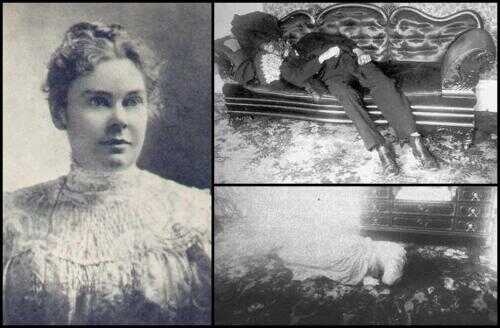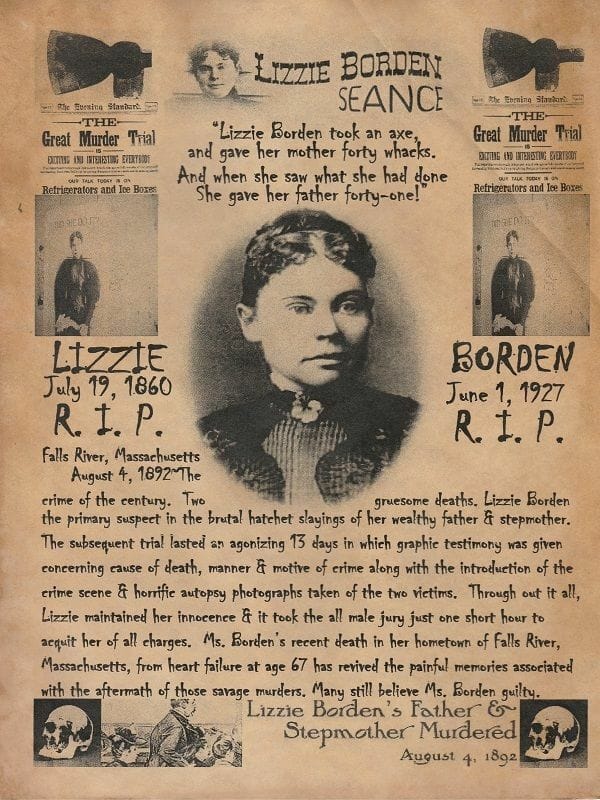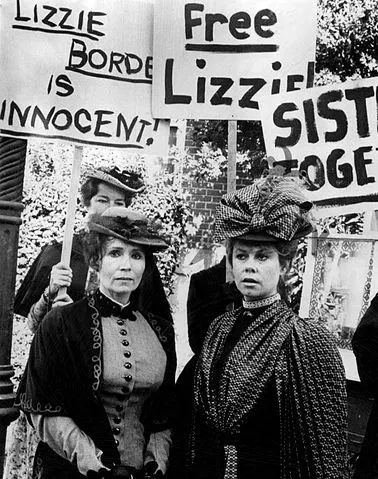Lizzie Borden is often remembered as one of America’s most notorious figures, primarily due to her alleged involvement in the brutal murders of her father, Andrew Borden, and her stepmother, Abby Borden, in Fall River, Massachusetts, on August 4, 1892. The case not only captivated the nation but also raised critical questions about gender, class, and the judicial system of the time.
The murders, characterized by their gruesome nature and the subsequent sensational trial, revealed deep societal rifts and highlighted the limitations faced by women in the late 19th century. As a woman accused of such a heinous crime, Lizzie’s experience was scrutinized through the lens of contemporary gender norms, which dictated how women were expected to behave in public and private.
This essay explores Lizzie Borden’s life, the events surrounding the murders, the ensuing trial, and the cultural impact that continues to resonate today. It will examine the historical context of Fall River, the dynamics within the Borden family, the investigation and trial process, and the legacy of Lizzie Borden in American culture.

Early Life
Birth and Family Background
Lizzie Andrew Borden was born on July 19, 1860, to Andrew Jackson Borden and Sarah Anthony in Fall River, Massachusetts. Her father, a prominent businessman in manufacturing and real estate, built his wealth through hard work and shrewd investments. Despite his financial success, Andrew was known for his frugality; he often lived modestly and was reputed to be averse to spending money unnecessarily. This frugality would later influence his daughters’ perceptions of him and their relationship with wealth.
Lizzie’s mother, Sarah, died when Lizzie was just two years old, leading to a significant void in her childhood. The absence of a maternal figure would have profound effects on Lizzie’s emotional development and family dynamics. After the death of Sarah, Andrew remarried in 1865, taking Abby Durfee Gray as his second wife. Abby was seen by many as a social climber, and her marriage to Andrew raised tensions within the family.
Childhood and Family Dynamics
Lizzie and her older sister, Emma, had a contentious relationship with their stepmother, often feeling that Abby was more concerned with controlling the household than nurturing them. The sisters believed that Abby was attempting to supplant their deceased mother. This resentment grew over time, leading to a profound sense of alienation from their stepmother.
The Borden family lived in a large, comfortable home, yet the atmosphere was often cold and unwelcoming. Andrew Borden’s strict demeanor and relentless work ethic meant that he was seldom present for his daughters, leading Lizzie and Emma to feel emotionally neglected. The dynamics within the household were further complicated by financial concerns, as the sisters worried about their inheritance and their father’s reluctance to distribute his wealth.
Education and Upbringing
Despite their father’s wealth, Lizzie and Emma were raised in a strict, religious environment that emphasized duty and propriety. Their education was limited; Lizzie attended local schools but was not given the opportunity for higher education, which limited her social mobility and independence. The lack of educational opportunities for women at the time restricted their roles in society, often confining them to the domestic sphere.
Lizzie found solace in her religious beliefs and often attended church with her family. However, her strict upbringing and lack of maternal affection contributed to her rebellious spirit in later years. This rebellion would manifest itself in various ways, including her relationships with social circles and her eventual actions surrounding the murders.

The Borden Family Dynamics
Tensions Within the Household
The Borden household was marked by tension, stemming from financial concerns and personal grievances. Andrew’s wealth was a source of contention, as both daughters felt entitled to a larger share of the inheritance. The sisters believed that their father prioritized his business over family, leading to feelings of resentment and betrayal.
Abby’s role in the household further complicated family dynamics. Lizzie and Emma often felt that Abby was trying to manipulate Andrew into changing his will to favor her biological family. This perception intensified their dislike for her and fueled the idea that they were being marginalized in their own home.
Conflicts and Relationships
As Lizzie reached adulthood, her relationships with both her father and stepmother grew increasingly strained. Lizzie frequently clashed with Abby, leading to a divide that would exacerbate tensions leading up to the murders. The sisters were often seen as rebellious, refusing to participate in the social norms expected of women at the time. Lizzie’s desire for independence clashed with her father’s controlling nature, leading to heated arguments and further alienation.
The relationship between Lizzie and Andrew was particularly fraught. Despite being financially supported by him, Lizzie resented her father’s perceived lack of affection. The conflict reached a boiling point when Andrew refused to provide financial assistance for a family vacation, leading to a significant rift between father and daughter.
Financial Concerns and Inheritance
The looming question of inheritance weighed heavily on Lizzie and Emma. They were acutely aware of their father’s wealth and the fact that he was not inclined to share it. Financial security was a central concern for many women of the time, and Lizzie and Emma feared being left with nothing. Their anxieties about inheritance were compounded by Andrew’s refusal to discuss his estate planning openly, leading to speculation and mistrust among family members.
The disagreements over money and property contributed to an atmosphere of hostility within the Borden household. This tension created a perfect storm for the events that would soon unfold, as the sisters felt increasingly marginalized and desperate for financial security.

The Murders
The Crime Scene
On the morning of August 4, 1892, Andrew Borden was found brutally murdered in the family home, with fatal blows to the head. The crime scene was gruesome; Andrew was discovered slumped on the living room couch, his face unrecognizable from the multiple hatchet wounds inflicted upon him. Shortly thereafter, Abby Borden was discovered in an upstairs bedroom, also the victim of a vicious attack, with her body lying face down and showing similar signs of brutality. The murders were shocking not only for their violence but also for the fact that they occurred in a seemingly secure family home.
The brutality of the attacks suggested a personal motive, leading investigators to focus their attention on Lizzie and Emma. The crime scene was chaotic, with blood splattered across the walls and furniture, suggesting that the killer was in a frenzied state. The lack of forced entry into the house further indicated that the murderer was likely someone known to the victims.
Initial Reactions and Lizzie’s Alibi
In the immediate aftermath of the murders, Lizzie claimed to have been in the barn searching for fishing gear at the time of the killings. However, her alibi was questionable, especially given her behavior—she was reported to have burned a dress shortly after the bodies were discovered, which raised further suspicion among investigators.
Witnesses noted that Lizzie seemed calm and collected in the face of the tragedy, which many interpreted as a sign of guilt. Her behavior during the chaotic moments following the discovery of the bodies was scrutinized heavily by both the public and the police, with many finding her demeanor unsettling.
As news of the murders spread, the local community was thrown into turmoil. Fall River, a small industrial town, was gripped by fear and fascination. The gruesome nature of the crime and the involvement of a seemingly respectable family captured the public’s imagination and led to rampant speculation about the identity of the killer.
Community Response and Investigation
The murders garnered immediate media attention, with the community in shock and speculation running rampant. The local police initiated an investigation, focusing on Lizzie as the primary suspect due to her proximity to the crime scene and perceived inconsistencies in her story. Detective John Morse, a family friend and the brother of Andrew Borden, was also scrutinized, as he had been visiting the Borden home the night before the murders.
Investigators conducted interviews with neighbors and family members, attempting to piece together a timeline of events leading up to the murders. The lack of concrete evidence made the investigation challenging, as there were no witnesses to the crime, and the weapon—the hatchet—was missing.
The media frenzy surrounding the case intensified, with newspapers publishing sensationalized accounts that depicted Lizzie as both a victim and a potential murderer. The coverage often sensationalized her life, including her social standing and family dynamics, further complicating the investigation and public perception.

Investigation and Arrest
The Role of Law Enforcement
The initial investigation was conducted by local police, who quickly identified Lizzie as a suspect. The investigation revealed several inconsistencies in her statements, and detectives noted her calm demeanor in the face of family tragedy. The police were under immense pressure to solve the case quickly, as public interest was mounting and the media coverage was relentless.
Law enforcement officers conducted a thorough search of the Borden home, looking for any evidence that could connect Lizzie to the murders. They collected various items, including clothing and household objects, but found little that definitively linked Lizzie to the crime. The absence of a weapon and the chaotic nature of the crime scene made it difficult for investigators to build a solid case.
Arrest and Charges
On August 11, 1892, Lizzie Borden was formally arrested and charged with the murders of her father and stepmother. The police cited her inconsistent statements and suspicious behavior as key reasons for her arrest. The decision to charge Lizzie was met with mixed reactions from the public, with many supporting her innocence while others were convinced of her guilt.
The legal proceedings were highly publicized, with the media portraying Lizzie as both a victim of circumstance and a potential murderer. The case became a sensation, with newspapers running headlines that sensationalized the crime and the trial. Lizzie was depicted as the “Ax Murderess,” and public opinion was sharply divided, with many believing in her guilt while others supported her innocence.
Public Perception and Media Sensation
The case received national attention, becoming a sensational story across newspapers. The portrayal of Lizzie in the media reflected societal attitudes toward women at the time. Many articles focused on her appearance, her behavior, and her relationship with her family, often reducing her to a caricature of a wealthy, troubled woman.
The sensationalism surrounding the case led to a frenzy of public speculation about Lizzie’s motives and mental state. Some viewed her as a victim of her oppressive family dynamics, while others painted her as a cold-blooded killer. This dichotomy in public perception added to the complexity of the case and influenced the trial proceedings.

The Trial
Pre-Trial Proceedings
The trial began on June 5, 1893, in New Bedford, Massachusetts. It was marked by public interest, with crowds gathering outside the courthouse daily. The courtroom was filled with spectators eager to witness the proceedings, and the atmosphere was electric with anticipation. Lizzie’s trial became a spectacle, with the media providing constant coverage and rehashing the details of the case.
The prosecution aimed to prove Lizzie’s guilt through circumstantial evidence, while the defense sought to highlight the lack of direct evidence linking her to the crime. The trial lasted 13 days, during which both sides presented their cases to the jury.
Arguments and Evidence Presented
The prosecution presented witness testimonies and physical evidence, such as the bloody dress Lizzie was seen burning. They argued that Lizzie had the motive, means, and opportunity to commit the murders, pointing to her strained relationships with her father and stepmother as evidence of her potential for violence.
Witnesses testified about Lizzie’s behavior on the day of the murders, describing her as calm and collected, which the prosecution interpreted as evidence of guilt. The prosecution also presented the idea that Lizzie had a financial motive, given her concerns about inheritance.
Meanwhile, the defense argued that the evidence was circumstantial and that Lizzie had no motive to kill her father and stepmother. They suggested that the possibility of a mysterious intruder should not be overlooked. The defense also highlighted the lack of direct evidence linking Lizzie to the murders, emphasizing that there were no eyewitnesses or physical evidence placing her at the scene of the crime.
The Verdict and Aftermath
After a brief deliberation, the jury acquitted Lizzie Borden on June 20, 1893. The verdict shocked many, as public opinion had been sharply divided throughout the trial. Lizzie was relieved by the outcome, but the acquittal did not bring her peace. The case raised questions about gender and class in the late 19th century, as Lizzie’s status as a woman influenced perceptions of her guilt or innocence.
Following the trial, Lizzie faced social ostracism despite her legal victory. The stigma of the murders followed her, and she became a figure of public fascination and speculation. Many in Fall River treated her with suspicion, and the Borden name was forever marked by the tragedy.

Post-Trial Life
Life After Acquittal
Following her acquittal, Lizzie and Emma moved to a new home, Maplecroft, in Fall River. The house was larger and more comfortable than the Borden family home, and the sisters hoped to start anew. Lizzie attempted to lead a quiet life, engaging in social activities and philanthropy, but she remained a figure of public fascination.
Lizzie became involved in various charitable organizations, including the local church and the Women’s Christian Temperance Union. She was known for her generosity and often donated to causes that supported women’s rights and social reform. However, her past continued to haunt her, and she struggled to find acceptance in the community.
Social Isolation and Controversies
Despite her attempts to reintegrate into society, Lizzie faced social isolation. The murders continued to follow her, and rumors about her involvement persisted. She was often regarded with suspicion by those who knew her, and her relationships with friends and acquaintances were strained.
In the years following the trial, Lizzie faced several controversies, including disputes over her inheritance and her financial management. Her relationship with Emma also became strained, leading to arguments over money and property. The sisters lived together for most of their lives, but tensions simmered beneath the surface.
Lizzie’s health began to decline in the early 1920s, and she became increasingly reclusive. Despite her social struggles, she maintained a sense of independence, refusing to be defined solely by her past.

Death and Legacy
Final Years and Death
Lizzie Borden died on June 1, 1927, from pneumonia at the age of 66. She was buried next to her parents in Oak Grove Cemetery in Fall River. Her death marked the end of a tumultuous life, one filled with notoriety and public fascination.
After her passing, Lizzie’s legacy continued to be a subject of intrigue. The unsolved nature of the murders and the ambiguity surrounding her guilt or innocence ensured that her story would endure in the annals of American true crime history.
Cultural Impact and Interpretations
The Borden case has inspired numerous works of fiction, films, and documentaries, becoming a significant part of American folklore. The infamous nursery rhyme “Lizzie Borden took an ax” is a testament to her lasting impact on popular culture.
Over the years, various interpretations of Lizzie’s story have emerged, ranging from sympathetic portrayals of her as a victim of circumstance to sensationalized depictions of her as a cold-blooded killer. The case has been the subject of countless books, articles, and theatrical adaptations, each offering a different perspective on the events surrounding the murders.
Continuing Fascination
The mystery surrounding the murders remains unsolved, leading to endless speculation and theories about what truly happened on that fateful day. Lizzie Borden’s story continues to captivate audiences, reflecting societal attitudes towards women, crime, and justice.
The Borden house has been preserved as a museum, attracting tourists and true crime enthusiasts who seek to learn more about the infamous case. Guided tours often recount the details of the murders, the trial, and the lasting impact of Lizzie’s life, ensuring that her story remains alive in the public imagination.

Lizzie Borden’s significance in the context of gender and class dynamics in the late 19th century
Lizzie Borden serves as a poignant reminder of the complexities of gender, class, and society at the turn of the 19th century. Her story encapsulates the tensions of a woman navigating a patriarchal world, where societal expectations and familial obligations often dictated the roles women were expected to play. Born into a family of considerable wealth, Lizzie was nonetheless confined by the constraints of her gender, illustrating the paradoxes of privilege and power.
In the late 1800s, women in America were largely relegated to the domestic sphere, expected to fulfill roles as dutiful daughters and wives, while men occupied positions of authority in both the home and society at large. Lizzie’s father, Andrew Borden, embodied this patriarchal structure; his wealth and influence afforded him considerable control over his family’s lives, yet his frugality and strict demeanor created an oppressive environment for his daughters. Lizzie and her sister Emma were acutely aware of their limited options for independence and self-determination, leading to escalating tensions within the Borden household.
The murders of Andrew and Abby Borden on August 4, 1892, not only shocked the community but also ignited a national debate about women’s roles and the potential for female violence. The media coverage of the trial reflected contemporary attitudes towards women, often portraying Lizzie as both a victim and a villain. This duality highlights the societal tendency to scrutinize and judge women’s behaviors against rigid standards of femininity. Lizzie’s alleged calmness in the wake of her family’s brutal murder was interpreted variously as composure or guilt, revealing the complexities of how women were perceived in times of crisis.
Moreover, the trial itself became a spectacle, drawing public fascination and igniting discussions about class dynamics. Lizzie’s affluent background contrasted sharply with the working-class communities in Fall River, where the murders took place. The case underscored the intersection of class and gender, as Lizzie’s wealth afforded her certain privileges—such as legal representation and public sympathy—while simultaneously subjecting her to scrutiny as a wealthy woman accused of horrific crimes.
In the end, Lizzie Borden’s legacy remains a topic of curiosity and debate, reflecting broader societal issues that resonate even today. Her story raises important questions about justice, morality, and the implications of gendered perceptions in the legal system. As we continue to explore Lizzie Borden’s life and the events surrounding the murders, we gain insight into the historical context of women’s struggles for autonomy and the societal forces that shape our understanding of their narratives. The enduring fascination with her case serves as a lens through which we can examine the complexities of human behavior, societal expectations, and the often fraught relationship between gender, class, and justice.
Final Words
The life of Lizzie Borden is a complex tale of family dynamics, societal expectations, and the quest for justice. While she was acquitted of the charges against her, the shadow of the murders has followed her through history, raising questions about gender, class, and morality. Lizzie Borden’s legacy endures, serving as a focal point for discussions on crime and punishment in America.
The Borden case offers a window into the societal norms and expectations of the late 19th century, particularly regarding women’s roles. Lizzie’s trial and the media frenzy surrounding it highlight the ways in which gender influenced perceptions of guilt and innocence, as well as the societal pressures that women faced.
In examining Lizzie Borden’s life and the events surrounding the murders, we gain insight into a historical moment that continues to resonate today. The case serves as a reminder of the complexities of justice and the enduring fascination with crime and its cultural implications. Lizzie Borden remains a symbol of mystery and intrigue, her story a cautionary tale of how societal expectations can shape individual lives and legacies.






